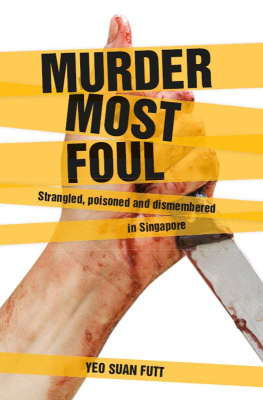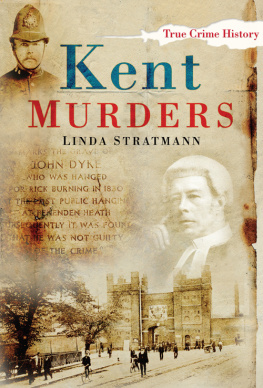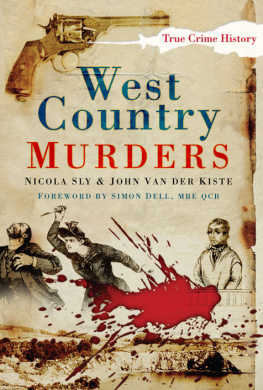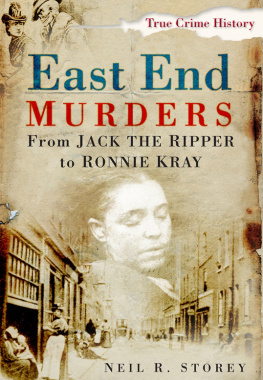MURDER MOST FOUL

2013 Yeo Suan Futt and Marshall Cavendish International (Asia) Pte Ltd
Published by Marshall Cavendish Editions
An imprint of Marshall Cavendish International
1 New Industrial Road, Singapore 536196
All rights reserved
No part of this publication may be reproduced, stored in a retrieval system or transmitted, in any form or by any means, electronic, mechanical, photocopying, recording or otherwise, without the prior permission of the copyright owner. Request for permission should be addressed to the Publisher, Marshall Cavendish International (Asia) Private Limited, 1 New Industrial Road, Singapore 536196. Tel: (65) 6213 9300, fax: (65) 6285 4871. E-mail:
The publisher makes no representation or warranties with respect to the contents of this book, and specifically disclaims any implied warranties or merchantability or fitness for any particular purpose, and shall in no events be liable for any loss of profit or any other commercial damage, including but not limited to special, incidental, consequential, or other damages.
Other Marshall Cavendish Offices:
Marshall Cavendish Corporation. 99 White Plains Road, Tarrytown NY 10591-9001, USA Marshall Cavendish International (Thailand) Co Ltd. 253 Asoke, 12th Flr, Sukhumvit 21 Road, Klongtoey Nua, Wattana, Bangkok 10110, Thailand Marshall Cavendish (Malaysia) Sdn Bhd, Times Subang, Lot 46, Subang Hi-Tech Industrial Park, Batu Tiga, 40000 Shah Alam, Selangor Darul Ehsan, Malaysia.
Marshall Cavendish is a trademark of Times Publishing Limited
National Library Board, Singapore Cataloguing-in-Publication Data
Yeo, Suan Futt.
Murder most foul : strangled, poisoned and dismembered in Singapore / Yeo, Suan Futt. Singapore : Marshall Cavendish Editions, 2013.
pages cm
eISBN : 978 981 4484 58 9
1. Murder Singapore. 2. Murderers Singapore. 3. Murder victims Singapore.
I. Title.
HV6515
364.1523095957 -- dc23 OCN837425277
Designed by Benson Tan
Cover photograph by Flavio Takemoto ( www.sxc.hu )
Printed in Singapore
Contents
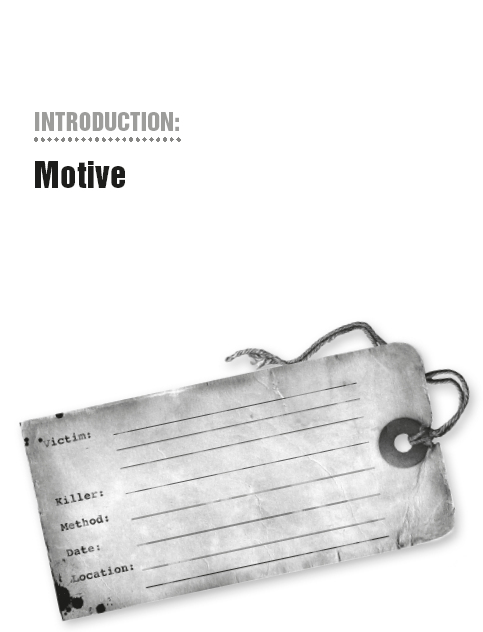
STABBED, drowned, strangled, bludgeoned variously killed, but not by chance. In this volume, we have compiled true accounts of the most heinous crimes committed in our nations short history, crimes of a most personal sort: murder.
Unlike most other crimes, there is no possibility of turning back here, an individuals life has been terminated with the finality of a full-stop, there is no recourse, no recompense. And distinct from cases where deaths have resulted from negligence, accident or circumstance, murder is written in malice, and often stewed in coldblooded calculation before it boils over in one terrifying, savage act.
Why do people commit murder? Its a question as old as the crime itself, and even if we had the answer under our very noses, its likely one we cannot universally accept.
Still, Singapore is among the safest places on earth to live as far as the United Nations Office on Drugs and Crime (UNODC) is concerned: along with Japan, Singapore has around 0.5 cases of intentional homicide per 100,000 population. Malaysia and Thailand stand at 2.3 and 5.3 respectively; UK and Australia each have 1.2; while the most murderous state, Honduras, tops the list with 82.
Our condolences, then, to the living as we share the stories of the dead. Its one way to remember them, like buildings and scenery that are no more.
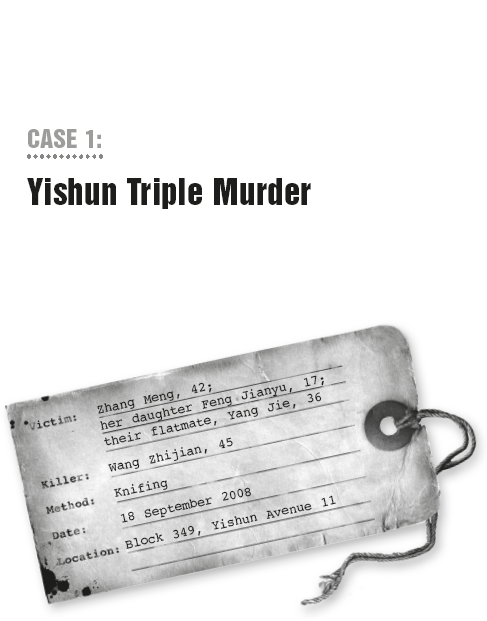
IN THE FACE OF declining population growth, which has lagged behind replacement levels since the 1980s, one of Singapores strategies for sustained economic growth and national rejuvenation has been to lower the barriers to immigration. This policy, which has been pursued with ever greater zeal in recent years, opened the floodgates to foreigners from varied lands of myriad monikers: Foreign Talent, who bring with them prized skills and contacts needed to elevate local businesses to world-class standard; Foreign Labour, who take on jobs shunned by locals, from laying bricks to cleaning tables; and PDMMs, or Pei Du Ma Ma, the thousands of largely middle-aged women from China on special passes, accompanying their young children studying in Singapore.
PDMMs have long attracted curiosity, not least because the media paints them as lonely women a fair number of them are divorced, and purportedly open to new liaisons who must do everything they can to fend for themselves and provide for their children in Singapores harsh economic climate, thousands of miles from husband and family support. But this curiosity exploded overnight in one of Singapores bloodiest murders, which occurred right in the heartlands, when a PDMM and her daughter were hacked to death by the formers lover. Their flatmate, another PDMM, was also killed, and her daughter only just survived after spending months in hospital for horrific wounds.
JUST TALKING
Tall and fair-complexioned with pronounced facial features, Wang Zhijian, age 45, looked very much like whats derisively called the Chinaman, found in great numbers on Singapores streets. Smiling for the cameras in many shots of the very public trial proceedings, Wang dramatically hardened the stereotype of the blue-collar PRC male, an image built on rough manner of speech and demeanour, and sensationalist reports of callous lawlessness and violent peasant riots in China itself. Yet as the trial unfolded, a more vivid picture emerged of the harsh realities of Wangs life, and in particular his all-consuming relationship with Madam Zhang Meng, 42.
Wang and Zhang first met in 1996 in their native Tianjin, the largest coastal city in northern China. They were introduced by a colleague of Wangs. Nothing much happened and they did not keep in contact. Three years later, they bumped into each other and struck up a conversation. Then in 2004, Wang was surprised when Zhang called him at home though he hadnt given her his number. They talked about his job as a storekeeper at the port, and she told him she worked as a forwarding agent. A year later, she called him again and asked him out to a coffeehouse for a chat. There, he found he could tell Zhang anything. He told her about his divorce a year before, how his marriage had broken down because he and his wife were no longer compatible. Zhang was a good listener, and at the same time said relatively little about herself.
From then on, they would meet every week, usually on Thursdays. Zhang would pick Wang up in her car and they would either go to a coffeehouse or a park, where they would talk. He grew to enjoy her company. Indeed, he liked her, but at this time it was all talk, there was no physical intimacy according to Wang, he was conservative.
This went on for months, but going out with a lady costs money, worse if one is too traditional to go Dutch. Soon, Wang could no longer afford to pay for their outings, but he kept this to himself and gave excuses that he had personal matters to attend to.
Yet he couldnt completely stay away. The festive season is especially bad for singles, ones loneliness accentuated by the festive cheer all round. Wang sent Zhang a text message wishing her Merry Christmas. She called back. It was good to hear her voice again, they chatted, it was easy. And soon they were going out again, seeing each other more often than before.
Next page
